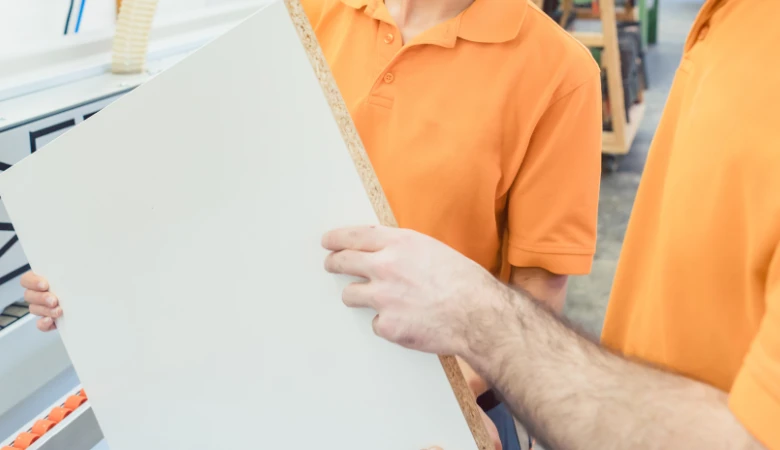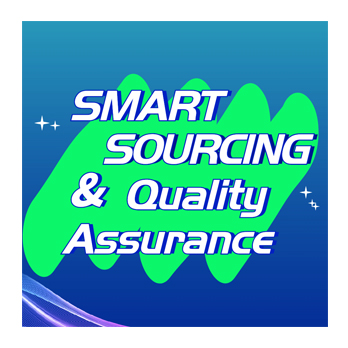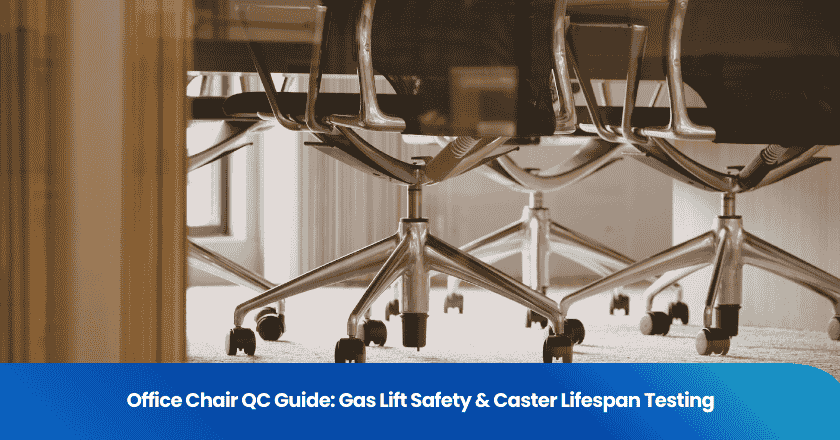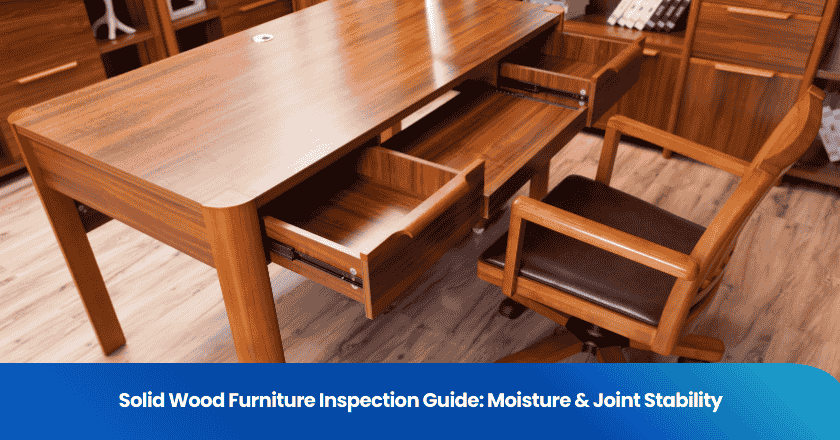
The regulatory landscape for office furniture continues to evolve in 2025. You now rely on quality inspection services to ensure every piece meets strict quality and safety requirements. These inspections verify that your furniture aligns with current regulations and maintains compliance at every stage. You gain peace of mind by choosing expert quality inspection services that help you identify risks, address concerns, and keep your workplace safe and compliant.
Key Takeaways
• Quality inspection services help ensure office furniture meets safety, durability, and environmental standards in 2025.
• Regular inspections catch problems early, reduce risks, and keep your workplace safe and compliant with changing regulations.
• Following updated US and Indian standards, including BIS and QCO, protects your business and builds trust with clients.
• Strong documentation and employee training are essential to maintain compliance and prepare for audits.
• Choosing experienced inspection providers and scheduling in-production and pre-shipment checks improve product quality and traceability.
Quality Inspection Services in 2025
Service Overview
You face a rapidly changing environment for office furniture in 2025. Quality inspection services now play a central role in your compliance strategy. These services help you verify that every piece of furniture meets strict safety, durability, and environmental standards. You can rely on these inspections to identify defects, assess construction, and confirm that your products align with the latest regulations.
You benefit from a comprehensive approach that covers a wide range of furniture types. Desks, chairs, storage units, and modular systems all require careful evaluation. Quality inspection services include visual checks, mechanical testing, and material analysis. You receive detailed reports that highlight any issues and recommend corrective actions.
Tip: Regular inspections help you catch problems early and avoid costly recalls or compliance violations.
You also gain access to specialized furniture testing. This process examines load-bearing capacity, stability, and flammability. You can ensure that your products not only look good but also perform safely in real-world office environments. Quality assurance becomes a routine part of your operations, giving you confidence in every shipment.
Inspection Process
You start the inspection process by scheduling a visit from a qualified inspector. The inspector reviews your documentation and examines your furniture on-site or at the production facility. You see a step-by-step approach that includes:
1. Pre-Inspection Review:
The inspector checks your product specifications and compliance documents. You confirm that all paperwork is up to date.
2. Visual Examination:
The inspector looks for visible defects, such as scratches, dents, or poor finishes. You receive immediate feedback on any cosmetic issues.
3. Mechanical and Functional Testing:
The inspector performs furniture testing to assess strength, stability, and durability. You see tests for weight limits, joint integrity, and moving parts.
4. Safety and Environmental Checks:
The inspector verifies that your furniture meets fire resistance and environmental standards. You ensure that materials are safe and sustainable.
5. Reporting and Recommendations:
You receive a detailed report outlining the results. The report highlights any non-conformities and suggests corrective actions.
You can use checklists to track each step and maintain thorough records. This process supports ongoing compliance and helps you prepare for future audits. You also benefit from third-party verification, which adds credibility to your quality claims.
Note: Consistent inspection and documentation protect your business and reassure your clients.
Why Compliance Matters
Safety and Quality
You play a crucial role in maintaining safety and quality in your workplace. When you invest in office furniture, you expect it to meet high standards. Reliable furniture supports daily activities and protects everyone in the office. Unsafe or poorly made furniture can cause injuries, disrupt workflow, and lead to costly accidents.
You need to focus on safety and quality because these factors directly affect employee well-being. Chairs, desks, and storage units must pass strict safety tests. You should check for stability, load-bearing capacity, and resistance to fire. These checks help you avoid hazards and ensure that your furniture performs as expected.
Regular inspections and adherence to standards give you confidence in your compliance efforts. You reduce risks and create a safer environment for everyone.
You also show your commitment to quality by following established procedures. Employees trust that you provide safe and reliable furniture. This trust boosts morale and productivity.
Regulatory Impact
You face increasing pressure to maintain compliance with regulations in 2025. New standards require you to document every step of your inspection process. You must keep records of safety checks, test results, and corrective actions. These records prove your compliance during audits or reviews.
If you ignore compliance with regulations, you risk penalties, recalls, or legal action. You may also damage your reputation. By following the latest standards, you protect your business and ensure that your furniture meets all requirements.
• Stay updated on changing regulations.
• Train your team on compliance protocols.
• Use checklists to monitor ongoing compliance.
You gain peace of mind when you know your furniture meets all safety and quality standards. Compliance is not just a legal requirement—it is a commitment to excellence and responsibility.
Furniture Compliance Requirements
US Standards
You must understand the core furniture compliance requirements for the US market in 2025. These requirements focus on safety, environmental impact, and flammability. You need to ensure that every piece of office furniture meets updated safety standards. These standards protect users from hazards and guarantee that products perform as intended.
You will encounter strict performance requirements for office furniture. These requirements include stability, load-bearing capacity, and resistance to tipping. You must also address environmental standards. Many regulations now require you to use sustainable materials and reduce harmful emissions during production.
Tip: Always review the latest federal and state regulations before introducing new furniture to your workplace.
You should pay close attention to flammability requirements. These requirements help prevent fire-related incidents and protect your employees. You must document all test results and keep records for future reference. This documentation supports your compliance efforts and prepares you for audits.
QCO 2025
You face new challenges with the introduction of qco in 2025. The qco sets out detailed furniture compliance requirements for manufacturers, importers, and distributors. You must understand the furniture categories covered under qco. These categories include desks, chairs, cabinets, and modular systems.
The qco outlines specific requirements for materials, construction, and labeling. You need to verify that your products meet these requirements before shipment. The qco also introduces new safety and environmental standards. You must test your furniture for durability, chemical emissions, and fire resistance.
You will find that qco emphasizes traceability. You must track each item from production to delivery. This process ensures that you can identify and address any issues quickly. The qco also requires you to maintain detailed inspection records. You should use checklists to monitor ongoing compliance and document every step.
Note: The qco will continue to evolve. You must stay informed about updates and adjust your processes as needed.
You should train your team on qco requirements. Regular training helps you avoid mistakes and ensures that everyone understands their responsibilities. You must also review your documentation regularly to confirm that it meets qco standards.
Documentation and Training
You cannot achieve compliance without strong documentation and effective training. You must keep accurate records of all inspections, tests, and corrective actions. These records prove that you meet furniture compliance requirements and support your claims during audits.
You should develop clear checklists for each stage of the inspection process. Checklists help you track progress and ensure that you do not miss any requirements. You must update these checklists as standards change.
Employee training is essential. You need to educate your staff about current requirements and best practices. Regular training sessions keep your team informed and prepared for new challenges. You should also encourage ongoing monitoring. Continuous oversight helps you identify issues early and maintain compliance.
Callout: Well-documented processes and regular training protect your business and build trust with clients.
You must treat compliance as an ongoing commitment. By focusing on documentation, training, and monitoring, you ensure that your furniture always meets the highest standards.
Compliance Guide
Choosing Inspection Providers
You need to select inspection providers who understand the latest requirements for office furniture. Look for providers with experience in bis, qco, and certification standards. Reliable inspectors help you manage the compliance process for manufacturers. They know how to check for safety, durability, and environmental requirements. You should ask about their training, reporting methods, and knowledge of bis certification. A good provider supports your compliance goals and helps you avoid costly mistakes.
Tip: Always verify that your inspection provider has up-to-date knowledge of bis and qco regulations.
Pre-Shipment and In-Production Checks
You must schedule both in-production and pre-shipment checks for your furniture. In-production checks catch problems early. Inspectors review materials, construction, and labeling during manufacturing. Pre-shipment checks confirm that finished products meet all certification and safety requirements. These steps help you maintain compliance and reduce the risk of non-conforming shipments.
• In-production checks: Monitor quality during assembly.
• Pre-shipment checks: Ensure finished furniture meets bis and qco standards.
Certificates and Traceability
You need to collect and organize all certification documents. These include bis certification, qco certificates, and other compliance records. Certificates prove that your furniture meets safety and environmental requirements. You should keep a traceability log for each item. This log tracks the product from production to delivery. Traceability helps you respond quickly if issues arise.
| Certificate Type | Purpose | Required For |
|---|---|---|
| bis certification | Proves compliance with bis | All furniture |
| qco certificate | Confirms qco requirements met | Desks, chairs |
| Safety certificate | Verifies safety standards | All products |
Common Challenges
You may face challenges such as changing regulations, incomplete documentation, or unclear certification steps. You need to update your compliance process regularly. Train your team on new bis and qco requirements. Use checklists to track each step. Third-party inspections add credibility and help you maintain continuous quality control.
Note: Staying proactive with documentation and certification protects your business and ensures ongoing compliance.
BIS and BIS Certification
What Is BIS?
You need to understand the role of bis in the office furniture industry. The bureau of indian standards, known as bis, sets the indian standards for products in india. You must follow these standards to ensure your furniture meets safety, quality, and performance requirements. The bis standard mark shows that your products comply with these indian standards. You see the mandatory use of bis certification for many office furniture categories in india. This requirement helps you maintain trust with clients and regulators.
You must recognize that bis certification is not optional. The bis conformity assessment regulations make it clear that you need certification for your products before you can sell them in india. You protect your business by following bis regulations and meeting all certification requirements. You also show your commitment to quality and safety.
BIS Certification Process
You start the bis certification process by submitting an application to bis. You provide detailed information about your products and manufacturing process. You must ensure your furniture meets all relevant indian standards. The bis certification process includes product testing, factory inspection, and document review. You work with bis officials to demonstrate compliance at every step.
You receive the bis certification after passing all tests and inspections. You can then use the bis standard mark on your products. This mark proves your furniture meets indian standards and bis regulations. You must keep your certification up to date by following renewal procedures and ongoing inspections. You should also stay informed about changes in bis regulations.
You benefit from expert bis certification assistance if you need help with the process. This support helps you avoid delays and ensures you meet all requirements. You must remember that bis certification is essential for selling office furniture in india. You build credibility and trust by maintaining compliance with bis and indian standards.
Tip: Keep all certification documents organized and ready for audits. This practice supports your compliance and helps you respond quickly to regulatory requests.
You gain significant advantages by using quality inspection services and maintaining compliance with bis standards. You protect your business in india and ensure every product meets strict bis requirements. You see how bis shapes the future of office furniture in india. You must review your compliance protocols and keep your team updated on bis changes. You improve safety and quality by following bis guidelines. You reduce risks and avoid penalties with proper bis documentation. You should consult experts for bis certification. You build trust with clients by showing your commitment to bis. You stay ahead by adapting to new bis regulations. You secure your place in the india market with strong bis practices.
Take action now—schedule your next bis inspection and update your compliance process for 2025.
FAQ
What types of office furniture require quality inspection in 2025?
You need to inspect all office furniture, including desks, chairs, cabinets, and modular systems. Each item must meet updated safety, durability, and environmental standards before use or shipment.
How often should you schedule furniture inspections?
You should schedule inspections at least once per production cycle. Regular checks help you catch issues early and maintain compliance with evolving regulations.
What documents do you need for compliance audits?
You must keep inspection reports, test results, certificates, and training records. These documents prove your compliance during audits and support your quality claims.
Why is traceability important in office furniture compliance?
Traceability lets you track each product from production to delivery. This process helps you respond quickly to issues and ensures every item meets regulatory requirements.
Can you use third-party inspectors for office furniture compliance?
Yes. Third-party inspectors provide unbiased assessments. They help you verify that your furniture meets all safety and quality standards.

Smart Sourcing & Quality Assurance Content Team
Article by Smart Sourcing & Quality Assurance Content Team
The Smart Sourcing & Quality Assurance Content Team is dedicated to delivering high-quality, easy-to-understand information that empowers our audience to navigate the complexities of global sourcing and quality assurance. Our team of writers has extensive experience in creating content across various fields, including procurement, supply chain management, quality assurance, market trends, and industry best practices. We specialize in sectors such as apparel, textiles, and consumer goods, providing targeted insights to help businesses in these industries optimize their sourcing strategies, ensure product quality, and maintain a competitive edge in the market.
Grow your business with TradeAider Service
Click the button below to directly enter the TradeAider Service System. The simple steps from booking and payment to receiving reports are easy to operate.



